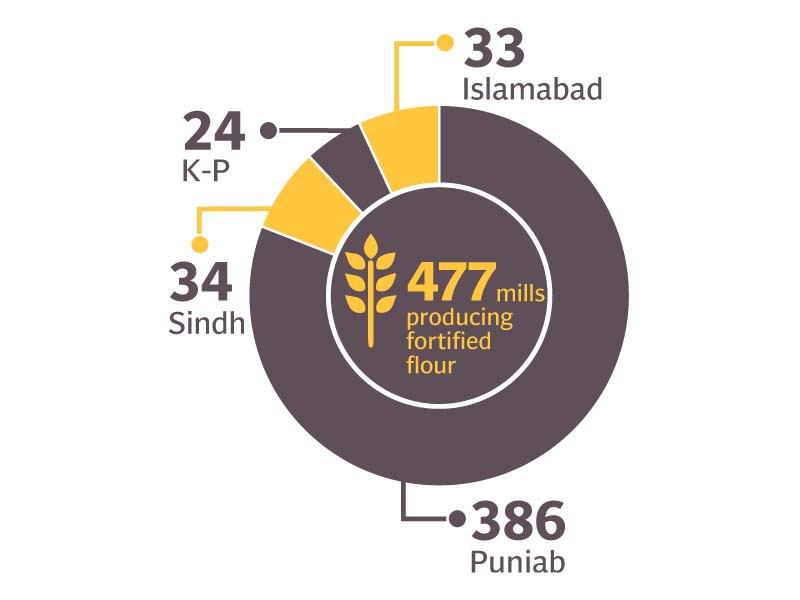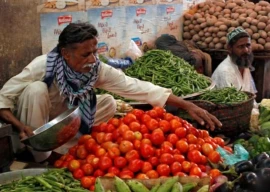
In order to overcome the major public health challenge of micronutrient malnutrition, the previous governments of Pakistan, together with the funding of international institutions, initiated the ongoing Food Fortification Programme (FFP). Under the initiative, the concept of ‘fortified flour’ was introduced.
Japan to spend $10.6m on nutrition, health
However, the incorrect policies of authorities, lack of research and strong reservations of public departments and industries at large, made it very difficult for the programme to achieve its goals.
The Pakistan Flour Mills Association and the Punjab Food Department termed the flour fortification process ‘unsatisfactory’ and suggested that a nutrition survey be carried out in Punjab’s urban and rural areas. The objective was to determine which nutrients are lacking among consumers.
According to details obtained by The Express Tribune, the Food Fortification Programme was initiated in 1998 and popularly known as the Foladi Aata (iron-containing flour) plan. An international nongovernmental organisation started working with the Pakistan flour mills association and factory owners were made an offer to install micro feeders on their plants to get the pre-mix free of cost.
From 2000 to 2003, more than 300 flour-mill owners installed micro feeders in their mills on a self-help basis and started preparing fortified flour. However, during the tenure of former president Pervaiz Musharraf, the project became stagnant after the introduction of the district system.
In later years, different governments and NGOs tried to continue the project, but remained unsuccessful. A few years ago, the previous government, through the British government’s programme UK Aid, stepped up their efforts to eliminate the food crisis in Pakistan. As a result, a national fortification alliance, under the federal health department, was formed and the Food Fortification Programme started anew.
As per the project requirement, a decision was taken to install free-of-cost micro-feeders in flour, oil, and ghee mills across all the provinces of Pakistan. The micro feeders, which were originally worth Rs700,000, were bought with the funding of the British government and are currently being provided to mill owners to include the pre-mix in flour.
Even though the provision of fortified flour would have considerably helped to alleviate the nutrition deficiency among the population, various hindrances, together with criticism from certain bodies, slowed down the project.
According to the data published by the FFP, out of more than 1,000 mills in the country, 477 started flour fortification. The report further said that in Pakistan, only 12% of the overall flour is fortified.
The FFP’s website’s data states that 386 flour mills in Punjab are producing fortified flour, while there are 34 such mills in Sindh, 24 in Khyber-Pakhtunkhwa and 33 in Islamabad. In Balochistan, none of the flour mills has started producing fortified flour.
It is worth noting that the current food fortification programme relies on data obtained through the national nutrition survey conducted in 2011.According to the country’s industrial organisations, the survey was “incomplete and unrealistic.”
According to the mentioned nutrition survey, five million children below the age of five die in Pakistan every year and 250,000 of them are lost to food shortages. The survey report said that 44% of children in Pakistan have iron deficiency, while 54% suffer from a lack of the Vitamin A. Another 40% are Vitamin D deficient.
Similarly, half of the female population in the country is anaemic, while 37% of pregnant women suffer from iron deficiency. Also, 46% and 69% of the country’s women are Vitamin A and Vitamin D deficient, respectively. Consequently, newborn babies birthed by nutrition-deprived mothers have weaker brains and are prone to other diseases.
Under Vision 2025, the current government intends to make the country ‘hunger-free’ and to that end, claims were made to eliminate food shortage, together with the introduction of new laws on federal and provincial levels to tackle the issue.
However, except for Punjab, there has been no progress in other provinces at all. The Pakistan standards and quality control department has set criteria for flour fortification according to which, in one ton of flour, 250 grams of pre-mix is added. The premix comprises folic acid, iron, and vitamin B-12.
International institutions involved in the project, however, have differences with local industries in Pakistan. A few days ago, the Pakistan flour mills association protested against Tauseef Janjua, the Pakistan representative of international institutions involved in the project. According to the flour mills association, Janjua has been harassing flour mill owners and has been compelling them to fortify flour even though the pre-mix provided by international institutions has expired. As a result, flour mills have now purchased their own pre-mix for the process of fortification.
Speaking to The Express Tribune, Pakistan flour mills association group leader Asim Raza said that women and children do face an acute lack of nutrition, but using a uniform approach to tackle the issue across the board is not the solution.
“In many of the areas of Punjab, residents don’t face deficiencies,” he said. “The government should, therefore, conduct an implementable and authentic national nutrition survey on the basis of which it should be decided which area lacks which nutrient and how fortification should be carried out.”
Asim Raza added that efforts were made to exert governmental pressure on flour mill owners, but it was resisted.
“We want to improve the health of the Pakistani nation, but it is important that governmental and international authorities take measures based on authentic facts and figures.”
When contacted, secretary food Punjab, Naseem Sadiq said that in order to reap maximum benefits of the FFP, a mapping must be carried out on the district level because the wheat/grains of each area are different.
“People belonging to different areas lack different nutrients in their bodies,” Sadiq said. “The current fortification programme has been designed by keeping the urban population in mind, whereas more than 60% of the population lives in rural areas. Therefore, a new survey must be conducted in rural areas to find out about deficiencies prevalent among people over there.”
He said that the desired objectives of the programme will not be achieved by implementing a Europe-tailored programme in Pakistan, especially in Punjab.
“People in every area have different eating habits and things are changing. Fifteen years ago, one person used to consume 1.25 kg flour per month, while nowadays, they consume seven kg flour in the form of rotis.
When contacted for a comment, Janjua – the focal person for international institutions -- said that he doesn’t have anything to say at the moment, however, he added that his communications department will get back to The Express Tribune later.
Published in The Express Tribune, May 26th, 2019.



1732503274-0/Untitled-design-(43)1732503274-0-165x106.webp)
1732501636-0/Untitled-design-(42)1732501636-0-165x106.webp)












COMMENTS
Comments are moderated and generally will be posted if they are on-topic and not abusive.
For more information, please see our Comments FAQ